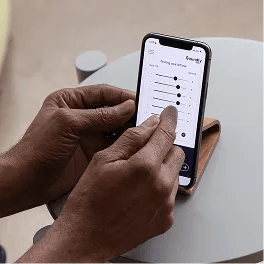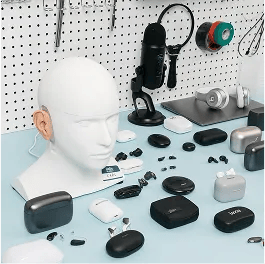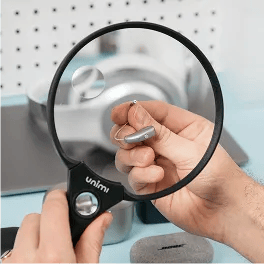Hearing loss changes how you experience sound. Songs get muddy, dialogue gets harder to follow, and even your favorite playlist can feel off.
The good news? Some headphones are built with clearer sound, smarter noise control, and better mic quality that can make a big difference.
This guide breaks down top picks for people with hearing loss—whether you’re after crisp music, better calls, or all-day comfort.
Here are the models we think stand out most.
- Look for adjustable EQs or hearing test features that match sound to your hearing profile.
- Battery life and comfort matter, especially for long listening sessions or commutes.
- Mic quality counts - the right headphones improve both what you hear and how clearly you’re heard.
- Compatible with hearing aids? Over-ear models often work best if you wear aids regularly.
- 50+ hearing aid brands reviewed and rated by our team of hearing aid wearers and audiologists
- 200+ hours each month spent researching brands and care options
- 2,000,000 people shopped on Soundly in 2024
- 100% independently owned and operated
Read more about our company, services and process here.
Featured in this article
These are the 5 best headphones for anyone with hearing loss. 👇
Apple AirPods Pro 3
- Earbuds and hearing aids in one
- Onboard hearing test via iPhone
- Quality sound in quiet environments
AirPods Pro 3 aren’t just for music anymore—they’re now an FDA-cleared hearing aid alternative built right into Apple’s ecosystem. For users with mild-to-moderate hearing loss, this device offers:
- Built-In Hearing Test: Apple’s custom hearing feature uses a short test to tailor amplification to your needs—no audiologist required.
- Dynamic Sound Enhancement: Speech sounds are emphasized while background noise is reduced, especially in quiet or moderate environments.
- All-in-One Convenience: For iPhone users, AirPods Pro 3 combine assistive listening, media streaming, phone calls, and noise management in one device.
- Many users report meaningful improvements in speech clarity during conversations, especially in quiet settings.
- The onboard amplification is simple to set up and at least somewhat effective for mild hearing loss.
- Users appreciate the seamless experience, with automatic adjustments based on environment and hearing profile.
- Performance is best in quieter spaces—some users note challenges in loud, group environments.
- Built-in hearing test with personalized amplification
- Seamless experience for iPhone users
- Offers hearing aid functionality without a prescription
- Great for phone calls and music
- Less effective in very noisy environments
- Requires some explaination when worn in social settings
- May not be comfortable for all-day wear for every user
Jabra Elite 7 Pro
- Personalized Sound: Customize your audio with the Jabra Sound app to match your unique hearing profile.
- Call Quality: MultiSensor Voice technology ensures clear, reliable calls in any environment.
- Noise Control: Adjustable Active Noise Cancellation lets you tailor sound isolation to your needs.
- Battery Life: Enjoy up to 8 hours of use per charge, with a total of 30 hours using the case.
The Jabra Elite 7 Pro combines personalized sound and advanced call features, making it a versatile option for diverse listening needs.
- Featuring Jabra MultiSensor Voice technology, these earbuds ensure crystal-clear calls with four integrated microphones and an advanced Voice Pick Up sensor, perfect for seamless communication.
- The adjustable Active Noise Cancellation allows for immersive music experiences, while the HearThrough technology lets users maintain awareness of their surroundings, accommodating various environments.
For those prioritizing adaptability and quality in their audio experience, the Jabra Elite 7 Pro offers a well-rounded solution that meets diverse sound and communication demands.
- Impressive Sound & Noise Cancellation: Users appreciate the excellent sound quality and effective noise cancellation, making these earbuds suitable for both workouts and daily activities.
- Customizable Listening Experience: The Jabra Sound app allows users to personalize their audio settings, enhancing their listening experience to suit individual preferences.
- Comfort & Lightweight Design: Many find the earbuds comfortable and lightweight for extended use, though some mention they occasionally struggle with fit.
- Effective Call Performance: The call quality receives high praise, with clear audio during conversations, which is valued by many users.
- Minor Fit Concerns: A few users note issues with fit, indicating the earbuds can sometimes be easy to misplace.
- Potential Drawbacks: Some mention volume consistency and rare allergic reactions to the ear gels, though these appear to be isolated incidents.
Users generally regard the Jabra Elite 7 Pro as a reliable choice for high-quality audio experiences.
- Clear call quality with advanced microphone technology.
- Customizable sound settings through the Jabra Sound app.
- Lightweight, compact design without compromising sound quality.
- Effective noise control with HearThrough technology.
- Noise cancellation might not be as strong as some competitors.
- Fit issues reported by some users, occasionally leading to discomfort or loss.
- Volume inconsistency experienced by a few users during playback.
Samsung Galaxy Buds Pro 2
- Customizable Sound: Galaxy Wearable app offers tailored EQ settings and an onboard hearing test for personalized audio.
- Active Noise Cancellation: Effectively reduces external noise, allowing users to focus on music or calls in louder settings.
- Comfortable Fit: Lightweight, ergonomic design with multiple ear tip options for secure, comfortable all-day wear.
- Seamless Connectivity: Easy pairing with Samsung devices and automatic source switching for uninterrupted audio.
The Samsung Galaxy Buds Pro 2 combine high-quality sound and practical functionality for a versatile listening experience.
- Enhanced Audio Control: Equipped with Samsung's Galaxy Wearable app, users can personalize sound settings, including an onboard hearing test and customizable equalizer, ensuring sound preferences align with individual needs.
- Noise Management and Comfort: The Intelligent Active Noise Cancellation effectively minimizes background noise, while the ergonomic design and multiple ear tip options provide a comfortable fit, making these earbuds suitable for extended use.
For users seeking adaptable sound quality and comfort, the Galaxy Buds Pro 2 deliver a well-rounded experience.
- Rich Sound Quality: Users appreciate the clear, immersive audio, especially for music and podcasts, though a few mention that bass levels could be slightly stronger.
- Effective Noise Cancellation: The Active Noise Cancellation performs well in noisy settings, though it may not match the strength of some high-end models.
- Comfortable Fit: Many users find the earbuds comfortable for extended wear with multiple ear tip options, but a few report occasional fit issues depending on ear shape.
- Easy Pairing and Device Switching: Galaxy Buds Pro 2 connect seamlessly with Samsung devices, allowing smooth transitions between phones, tablets, and more.
- Decent Battery Life: Battery life meets most users' daily needs, although some note it may require frequent charging for prolonged use.
- Minor Connectivity Hiccups: A few users report occasional signal drops, particularly when the device is at a different height, but most find connectivity stable and reliable.
Overall, users find these earbuds deliver solid value for versatile, high-quality audio experiences.
- Strong active noise cancellation for better focus in busy environments
- Personalized sound settings via the Galaxy Wearable app
- IPX7 water resistance for worry-free workouts and light rain
- Stable, automatic switching between paired Samsung devices
- Comfortable fit with multiple ear tip options
- Touch controls may be too sensitive, leading to accidental taps.
- Limited compatibility as Galaxy Wearable app isn’t available for iPhone users.
- Battery life may require frequent charging with extended active noise cancellation use
- Occasional signal drops reported when paired device is at a different height
- Noise cancellation may not match that of higher-end models
Sony WH-1000XM5
- Personalized Sound: Impressive preset options or a fully customizable EQ with five bands of adjustment.
- Battery life: Up to 30 hours on a single charge
- Comfort: Comfortable, lightweight option with vegan leather ear cups and a slightly larger size
- Phone call quality: Sony can compete with the best in shutting down background noise and isolating your voice.
The Sony WH-1000XM5 delivers an impressive mix of advanced noise-canceling technology, comfort, and battery life. Designed to offer an immersive listening experience, these headphones are ideal for users who want uninterrupted audio quality and clear communication on the go.
- With advanced noise cancellation powered by two processors and eight microphones, these headphones reduce external sounds, creating an isolated listening environment ideal for both commutes and busy workplaces.
- The hands-free calling feature includes four beamforming microphones, allowing for clear voice transmission even in noisy settings—an essential for professionals and those who prioritize clear conversations.
Overall, the Sony WH-1000XM5 combines high-end audio, comfort, and functionality, making it a top pick for users seeking reliable sound quality and convenience in any setting.
- Rich Sound Quality: Users appreciate the high audio clarity, making music and calls sound immersive and full.
- Powerful Noise Cancellation: The noise-canceling feature is widely praised, allowing for distraction-free listening even in loud settings.
- All-Day Comfort: Many find the lightweight design comfortable, noting it’s well-suited for long listening sessions.
- Intuitive Touch Controls: Users highlight the convenience of touch controls for easy playback and call management.
- Long Battery Life: With up to 30 hours of use, battery performance is a popular feature, plus the quick charge option for added convenience.
- Slight Bulk: Some mention the ear cups feel a bit large, which can impact portability.
Overall, users find the Sony WH-1000XM5 to deliver a comfortable, high-quality experience, ideal for uninterrupted listening.
- Beautiful and comfortable design
- 30 hours of battery life
- Customizable EQ
- Works with all phone types
- Easy earcup tap and swipe controls
- Bulky for travel
- Transparency mode is not quite as good as Airpods Max
- Ears can become hot after a long wear-session
Jabra Enhance Select
- Bluetooth enabled and rechargeable
- 100-day risk-free trial
- Nearly invisible with a sleek design
- Professionally programmed before shipping to your home
The Jabra Enhance Select 700 offers an impressive blend of clinic-grade technology, affordability, and user convenience. Here’s why it stands out:
- Professional-Grade Technology at a Lower Price: Jabra’s Enhance Select 700 provides the advanced sound quality of clinic-only brands like ReSound but at less than half the price.
- Professional Programmed Hearing Aids From Home: Jabra’s pre-programmed approach ensures a personalized fit without needing in-clinic visits—customers simply take or upload a hearing test, and Jabra's audiologists program the hearing aids before shipment.
- Seamless Bluetooth Streaming: Equipped with LE Audio, the Enhance Select 700 delivers high-quality, direct streaming for calls and media, with excellent sound quality and range.
- Purchase Perks: Jabra offers 100-day returns, unlimited remote adjustments, and seven-day-a-week customer support.
Overall
Users commend the Jabra Enhance Select 700 for its natural sound quality, discreet design, and effective customer support. Many report significant improvements in hearing clarity and comfort.
Positives
- Natural Sound Quality: "The sound quality is excellent, and the ability to adjust settings via the app is a great feature." — Timothy T.
- Discreet Design: "These hearing aids are virtually invisible and very comfortable to wear throughout the day." — Angel M.
- Customer Support: "The customer service team was incredibly helpful and guided me through the setup process with ease." — Damian.
Complaints
While the majority of feedback is positive, some customers have reported issues with device durability and the need for adjustments. However, these concerns are relatively infrequent compared to the overall satisfaction expressed by users.
For a comprehensive view of customer experiences, you can visit Jabra Enhance's review page.
- One of the most affordable and convenient ways to purchase online while maintaining professional care
- Comes with a 100 day free-return period
- Offers rechargeable batteries and Bluetooth streaming
- Remote care requires users to be somewhat tech savvy
- Jabra only offers styles that sit behind the ear
- Jabra Enhance Select is a fully customizable, prescription hearing aid appropriate for mild-severe hearing loss
- If you have severe hearing loss and struggle with feedback (squealing) you may need a custom earmold (not available through Jabra Telehealth)
- If you have profound hearing loss, you may be a better fit for a high-powered BTE style hearing aid (note available through Jabra Telehealth)
- Jabra is a remote care brand that programs and delivers your hearing aids through Telehealth
- Take or submit a hearing test and a Jabra professional will program your hearing aids and ship them to your door
- Three years of unlimited support is included with every purchase
- Jabra Enhance Select hearing aids come with the capability for remote adjustments. This feature means you don't need to ship your hearing aids back to get program updates
- Jabra Enhance Select is manufactured by GN Hearing (the makers of ReSound hearing aids)
- Jabra devices come with a strong set of background noise handling features and app controls
- Jabra Enhance Select comes in a small and comfortable receiver-in-canal style that is easy to wear all day
- Sits behind the ear with a receiver (speaker) that reaches into the ear canal
- The form factor of Jabra Enhance Select is comparable to ReSound hearing aids
- Choose between five colors including: Sparkling Silver, Champaign, Gold, Bronze and Warm Grey
- Jabra Enhance Select offers three levels of technology. Select 500 and Select 300 come with rechargeable batteries and as of May 2024, Select 50 also comes with rechargeable batteries
- 30 hours on a full charge
- Comes with a portable charger (does not need to be plugged in)
- All Jabra Enhance Select technology levels allow Bluetooth streaming, music listening, and phone calls.
- Jabra Enhance Select 500 uses Bluetooth LE Audio (Auracast ready) and is handsfree for iPhone (11 and newer) and compatible Android models
- Jabra Enhance Select 300 allows iPhone users to take calls hands-free, while Android users must keep their phones close to pick up outbound audio
- Jabra Enhance Select 300 uses Apple's MFI connection and Android's ASHA connection to stream content through Bluetooth
- Jabra Enhance Select is reasonably easy to handle but does require the wearer to place the hearing aid behind their ear and insert the receiver into the ear (consistent across all behind-the-ear styles)
- If dexterity is a concern we recommend Select 300, which is larger and easier to grasp than the microRIE (Select 500)
- The Jabra Enhance Select charge case uses induction charging and is fairly easy to handle
- All levels of Jabra Enhance Select have an IP rating of 68
- These hearing aids can withstand dust and water submersion in one meter of water for up to 30 minutes
- Customization: Treble/bass, volume, microphone directionality
- Jabra Enhance Select includes Telehealth capabilities through the Jabra app
Bose QuietComfort Noise Canceling Headphones
- Customizable Noise Control – Switch between full noise cancellation and Aware Mode to adjust to your surroundings.
- Long-Lasting Battery – Enjoy up to 24 hours of continuous playback, with a quick 15-minute charge adding 2.5 hours of use.
- Personalized Audio Experience – Adjustable EQ lets users fine-tune bass, midrange, and treble for a tailored sound.
- Multi-Device Connectivity – Seamlessly switch between devices without manually disconnecting and reconnecting.
The Bose QuietComfort Noise Canceling Headphones offer a well-rounded mix of immersive sound, effective noise cancellation, and long-wearing comfort, making them a solid choice for the most comfortable over ear headphones.
- Adaptive Listening Modes – With Quiet and Aware Modes, users can seamlessly switch between full noise cancellation for focused listening or situational awareness when needed, making these headphones practical for both travel and daily use.
- Comfort and Battery Life – Plush earcup cushions and a padded headband provide lasting comfort, while the 24-hour battery life ensures extended listening without frequent recharging. A quick 15-minute charge adds 2.5 hours of playtime for added convenience.
With a balance of strong noise cancellation, user-friendly features, and all-day wearability, the Bose QuietComfort headphones suit listeners looking for both immersion and flexibility in their audio experience.
- Comfortable for All-Day Wear - Users highlight the plush ear cushions and lightweight design, making these headphones comfortable for long listening sessions without ear fatigue.
- Effective Noise Cancellation - The noise cancellation is widely praised for blocking out background noise, though some users note it struggles with sharper sounds like barking dogs.
- Balanced, High-Quality Audio - Listeners appreciate the rich bass and clear mids and highs, with many finding the adjustable EQ useful for personalizing their sound experience.
- Reliable Battery Life & Quick Charging - With up to 24 hours of battery life, users enjoy extended listening time, and the 15-minute quick charge feature is a convenient bonus.
- Build Quality & Controls Could Be Improved - Some reviewers mention that the buttons feel less premium than expected and note occasional connectivity glitches.
Overall, most users find the Bose QuietComfort headphones a worthwhile investment, especially for those prioritizing comfort and immersive sound.
- Effective noise cancellation for blocking out background noise in busy environments.
- Comfortable design with plush ear cushions and a padded headband for extended wear.
- Long battery life with quick charging for on-the-go convenience.
- Adjustable sound settings via the Bose app for a personalized audio experience.
- Wired and wireless options for flexibility when the battery runs low.
- Noise cancellation isn’t perfect for high-pitched or sudden sounds like barking.
- Buttons feel less premium compared to the overall build quality.
- Occasional Bluetooth connectivity issues when switching between multiple devices.
How personalized audio works for hard-of-hearing listeners.
Before we talk about products and brands, let's take a look at how this works. I'll use my own hearing loss for illustration. I have a genetic cookie-bite hearing loss, so I need more volume in mid-frequencies. Here are my results from our 5-minute hearing test.
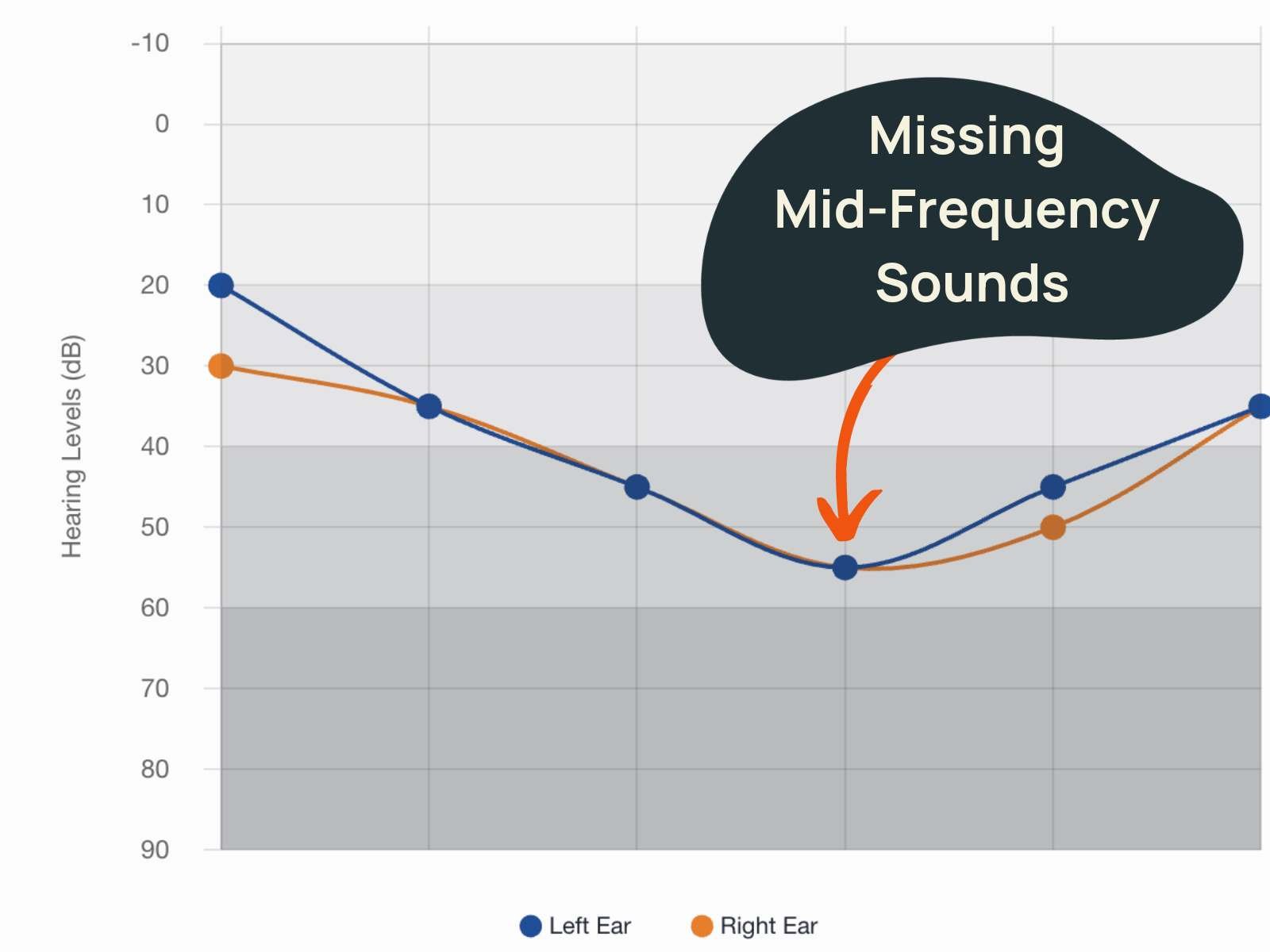
If I put on a pair of un-customized headphones, I'll need to crank up the volume to get those middle frequencies to a normal level. The problem is that the low and high frequencies are then too loud. I'm stuck.
Headphones with custom audio solve this issue by correcting the mid-frequency without boosting my lows and highs. Some custom headphones do this by administering a short hearing test, while others give me access to a freeform equalizer (more on that below).
Even if you don't have significant hearing loss, you still have one-of-one hearing, and you'll almost certainly like the sound better when it's matched to your specific needs.
Enter headphones with personalized audio, hearing tests, and custom equalizers.
Now that you understand the magic (or necessity) behind personalized headphone sound, let's talk about products.
As with any headphone purchase, you'll probably consider a few factors when deciding on the perfect audio companion:
Final Thoughts
If you have hearing loss and are tired of muddy lyrics or frustrating phone calls, the best headphones for hearing impaired listeners featured in this guide are a great place to start.
Of course, there are other options out there. Just ensure the devices you are looking for have an adjustable EQ or a built-in hearing test.
Oh... and get ready to hear the actual lyrics for all the songs you've been singing wrong.



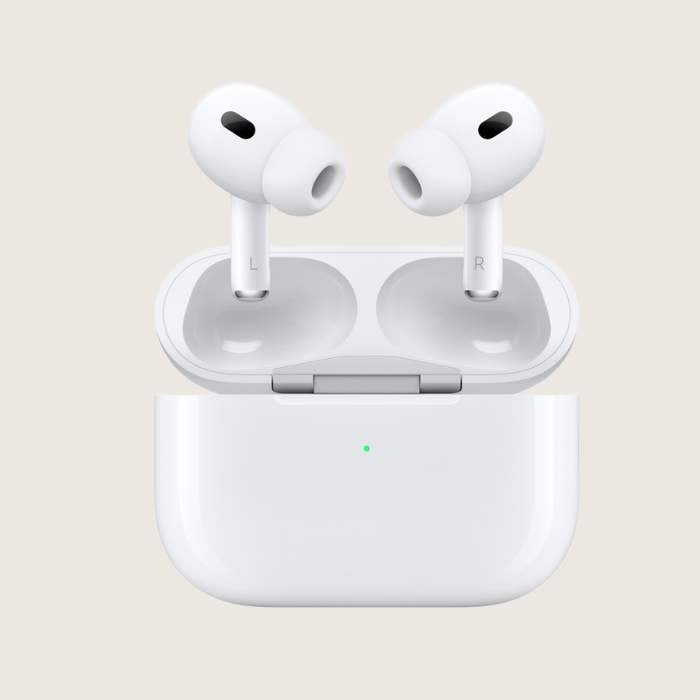
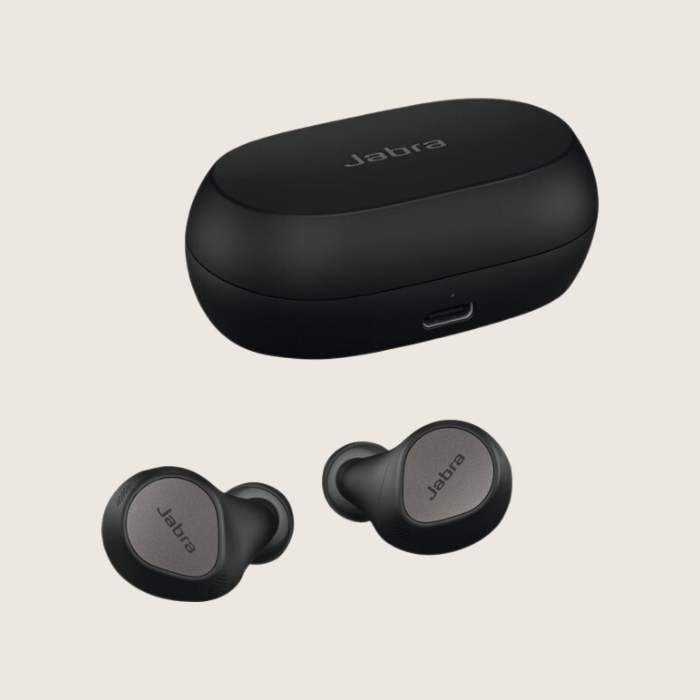
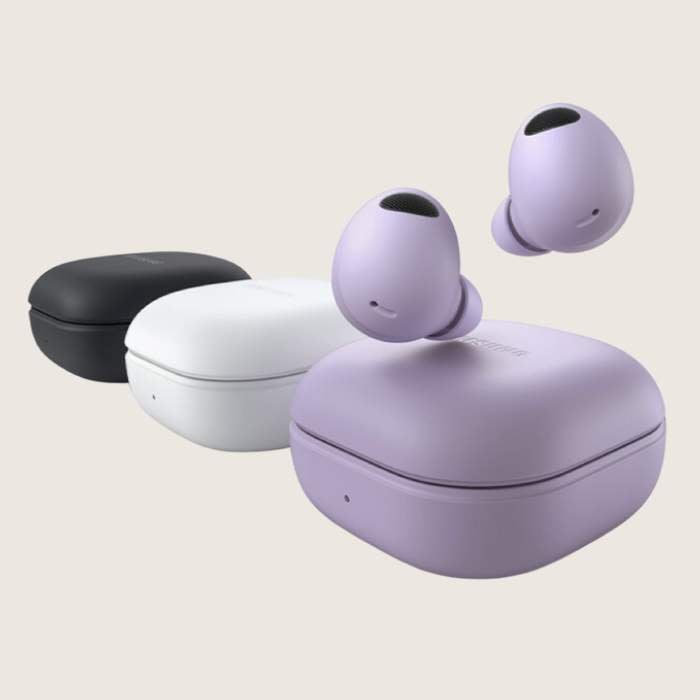
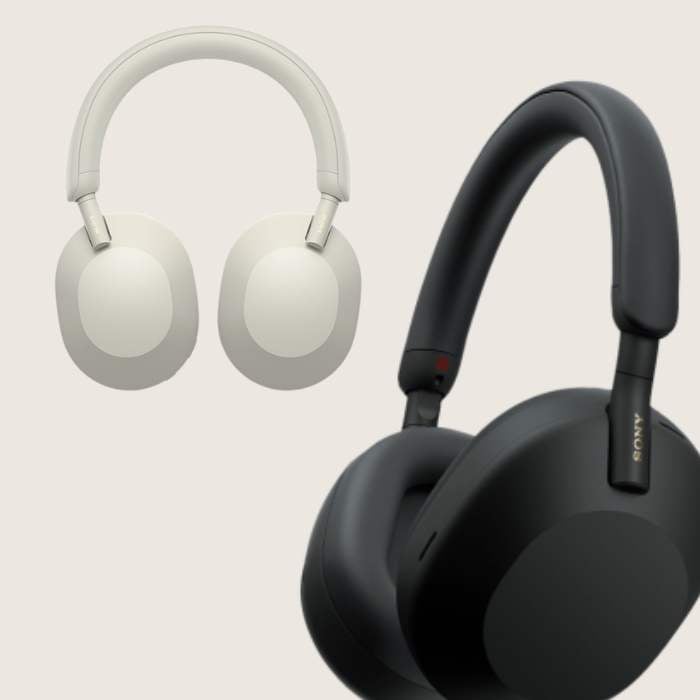

.jpg)
